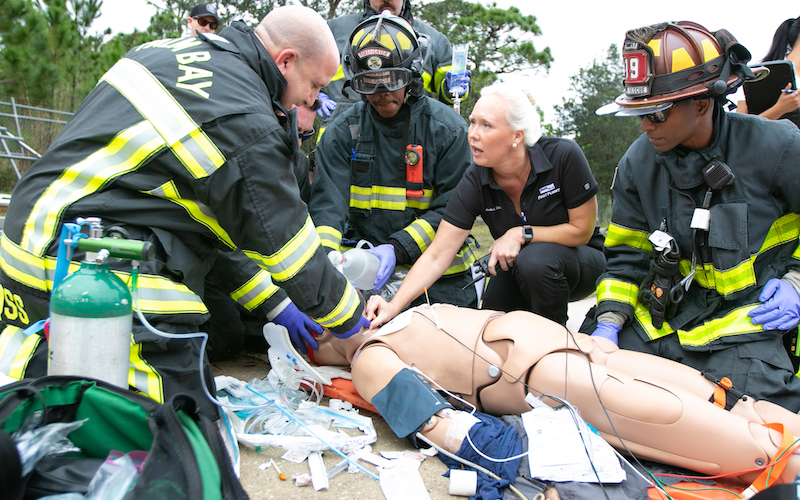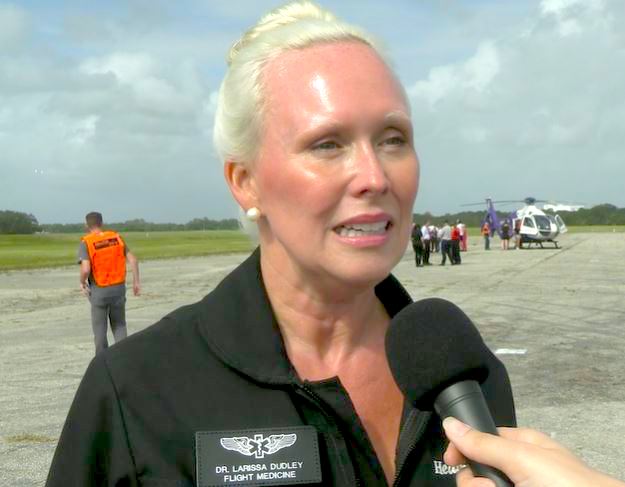Health First’s First Flight EMS Medical Director Stresses Safety as E-Bike and Scooter Injuries Surge in Brevard County
By Space Coast Daily // August 16, 2025
Health First First Flight EMS Medical Director Dr. Larissa Dudley urges riders to use better helmets and follow traffic rules

BREVARD COUNTY, FLORIDA — Electric bikes and motorized scooters are growing in popularity across Brevard County, offering a quick, eco-friendly way to travel. But as their use increases, so do the calls for emergency medical responses.
Dr. Larissa Dudley, MD, EMS Medical Director for Health First’s First Flight, says the trauma team is now treating e-bike and scooter injuries every week — sometimes daily.
The injuries can be life-altering. Riders have arrived with traumatic brain injuries, facial and skull fractures, collapsed lungs and multiple fractures to the arms, legs, hips, wrists, or ankles. While these can occur in any crash, Dudley notes that head injuries remain the most frequent — and the most dangerous.
A significant factor is helmet use — or the lack of it. Some patients arrive without any helmet. Others wear bicycle helmets that were never designed for the speeds e-bikes can reach. In many cases, helmets are not fastened securely, greatly reducing their effectiveness.
Florida law states: “A bicycle rider or passenger who is under 16 years of age must wear a bicycle helmet that is properly fitted and is fastened securely upon the passenger’s head by a strap and that meets the federal safety standard for bicycle helmets.”
While that statute covers traditional bicycles, Dudley says it does not fully address e-bikes, which are capable of much higher speeds. She believes helmets designed for motorcycle riders offer far better protection in an e-bike crash.
“E-bikes fall into a unique category and our safety regulations haven’t fully caught up with the speeds and risks they present,” Dudley explained. “The assumption that a standard bicycle helmet offers adequate protection is likely incorrect. Given the higher velocities involved, riders would be better protected with a motorcycle-rated helmet.”

Higher speeds mean greater impact forces — and a greater risk of severe head injury. Dudley says the injury patterns from e-bike crashes often resemble those seen after motorcycle collisions rather than bicycle falls.
She recommends riders choose protective gear accordingly — not only for the head, but also for the knees, elbows, and skin. Many patients arrive in minimal protective clothing, leaving them highly susceptible to severe abrasions, commonly referred to as “road rash.”
Collisions with vehicles account for most of the serious cases. While some crashes involve stationary objects such as telephone poles, street signs, or even pedestrians and other bicycles, Dudley says, “More often than not, the serious injuries end up happening with collisions with cars.”
These incidents span all age groups. “It’s a little bit all over the place… whoever has them — they’re getting injured,” she said. Based on her observations, e-bike crashes are more common in beachside areas, where the e-bikes are more frequently used.
As the county’s only Level II trauma center, Health First’s Holmes Regional Medical Center is equipped to treat the most serious injuries from across Brevard — including the life-threatening head and orthopedic trauma often seen in e-bike and scooter crashes.
When minutes matter, First Flight often provides the fastest route from the scene to advanced care. “Most often, flight is the quickest way to get them there,” Dudley said.

With two helicopters now stationed in Brevard — one at Melbourne Orlando International Airport and one at the Titusville-Cocoa Airport — crews can reach crash scenes on both ends of the county more quickly than ever, helping ensure patients arrive at the appropriate facility in the shortest possible time.
Even with this expanded capability, Dudley says every case is evaluated to determine whether air or ground transport will reach definitive care faster. Weather conditions, aircraft availability, and distance all factor into the decision. In some cases, ground transport is most practical; in others, the helicopter is the clear choice.
Whatever the method, the objective is the same: to move patients from the scene of an e-bike or scooter crash to the right level of care as quickly as possible. In trauma medicine, this critical period is known as the “golden hour” — the first 60 minutes after an injury, when timely treatment can have the greatest impact on survival and recovery.
Prevention, Dudley emphasizes, is the most effective intervention — and it begins with changing public perception of e-bikes. One of the most dangerous misconceptions, she says, is treating them like traditional bicycles. Their higher speeds and heavier frames mean the forces in a crash are significantly greater, producing more severe injury patterns.
Her advice to the community is clear. Wear a helmet — and not just any helmet. Ensure it is properly fitted, securely fastened and rated for the speeds an e-bike can achieve. Follow all traffic laws: stop at stop signs and red lights, signal before turning, and remain alert to surrounding traffic.
Younger riders may face additional risks if they lack the driving experience needed to navigate traffic safely. Those unfamiliar with traffic rules may not anticipate hazards the way experienced drivers do.
“These accidents are preventable,” Dudley emphasized. The right gear, the right helmet and the right habits on the road can save lives.
Dudley’s message is clear — ride prepared and protect yourself every time, because your life could depend on it.














